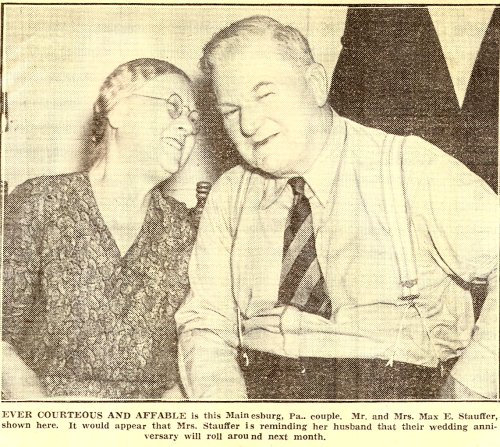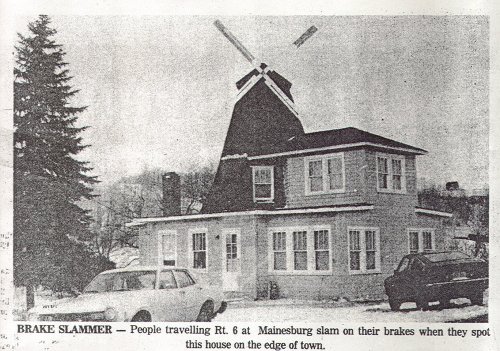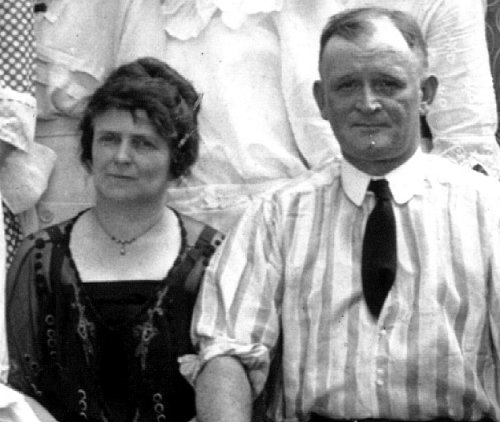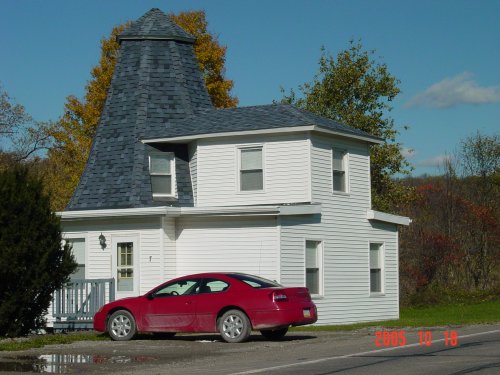|
 |
THIS IS ONE of a series of Elmira Sunday Telegram articles, appearing from time to time, explaining how villages in the New York and Pennsylvania territory served by The Sunday Telegram, received their names.
WHEN SOMEONE seeks information concerning Mainesburg, pa., he consults Max E. Stauffer, former blacksmith. Mr. Stauffer, except for one period of less than three years, has spent his entire 68 years in this little community on Corey Creek in Sullivan Township, Tioga County. Mainesburg took its name, Mr. Stauffer explains, from John Maine, who more than 100 years ago, settled in what was almost virgin wilderness. In 1826 the place was established as a village. Nearly all the land around the small community between Sylvania and Mansfield was early acquired by the Maine family. [Note From Joyce - This is not quite true, but John Maine was the first postmaster and that is how the name was established] Later, of course, these holdings were sold off a little at a time. Mr. Stauffer, naturally, cannot remember the original John Maine but he does recall the pioneer settler’s two sons, both long since dead. They were Dr. George W. Maine, pioneer physician, and E. R. Maine, farmer. Like so many other villages and hamlets, Mainesburg from the earliest was a lumbering and farming community. Mr. Stauffer’s father, George E. Stauffer, who was 62 when he died in 1897, 42 years ago, was a pioneer blacksmith and it was from him his son learned the trade. The elder Mr. Stauffer was a blacksmith nearly 45 years and his son, before retiring five years ago, matched that record. Mr. Stauffer can remember when a saw mill flourished on Corey Creek, near where the highway crosses the stream. When Mr. Stauffer as a boy knew the sawmill, it was operated by L. M. Doud and J. S. Woodburn. There was also a flour and feed mill on the western outskirts of the place, operated by A. B. Austin and belonging to C. M. Horton and his brother, Frank. This burned down some 45 years ago. Disastrous fires in years past were blows to the community. In 1917, the Christian Church, of which Mr. Stauffer was a trustee, burned down and with it were destroyed a Grange hall, store, and other buildings. Corey Creek has dwindled away so that it no longer supports fishing, but in his youth, Mr. Stauffer recalls, it was no task at all to catch a full creel of trout “right in the village limits.” When, a half century ago, Mr. Stauffer donned an apron and became his father’s helper in his smithy, there were then three other blacksmiths, all now dead. These were Stephen Peters, Fred Bryan and Lewis B. Lucas. L. D. Lucas, a son of the latter, carried on the trade after his father for a time. Mr. Stauffer was born in the house in which he now lives. His father’s home it was as well, and previously to that, Dr. George W. Maine, previously mentioned, lived there. Consequently, the house, still comfortable and homelike, is well over a century old. When a young man, Mr. Stauffer went to Kansas for a time. There he met and wed Miss Laura M. Kuntz, a native of Punxatawny, Pa. In February, Mr. and Mrs. Stauffer will celebrate the 47th anniversary of their marriage. The Stauffers have one son, Gordon E., who operates a store at Mainesburg and is postmaster.
See Mainesburg Postcards by Caulkins
showing the buildings that burned in 1917.
|
ELMIRA SUNDAY ADVERTISER June 27, 1886
Typed by Sherry Nichols
A MOST REMARKABLE MAN
INCIDENTS IN THE LIFE OF VET. BAILEY, A FAMOUS OLD HUNTER
A Modern Sampson Whose Feats Were Unparalleled for Bravery and Whose
Endurance Was Simply Marvelous.
(Written expressly for the Telegram by an old correspondent)
One of the most remarkable and eccentric pioneers of Rutland and Sullivan townships in Tioga county, PA, was Sylvester Bailey, better known as “Vet Bailey”. He was born in the state of Connecticut about the year 1798, and came into the Tioga valley with his parents when he was about eight years of age, riding a pony all the way from that state and carrying a small rifle by his side. The hunting and shooting traits for which in after life he was so greatly distinguished, commenced their development upon that journey, shooting and killing a number of deer along the road in the Catskill and Delaware mountains, along the Chenango and Chemung valleys, and in the mountains intervening between the towns of Towanda, Troy, and on the Armenias. His father first located at the mouth of Mill creek, and subsequently removed to Rutland. Vet. was a sturdy, square-built boy, fearless of danger, and rugged and firm as the mountain country which he inhabited. Before he was twelve years of age he had killed 100 deer or more, and at the age of twelve he shot his first panther. He would roam over the mountains barefoot, defying frost and ice, in quest of game, and when his feet became too much chilled he would pull off his hat and step into it, and thus bring back the circulation. Twas thus he spent his youth and boyhood. In time he turned his attention to business, which he prosecuted with great, energy, building saw mills and grist mills and erecting dwellings. He married Miss Mary Welch, a native of Vermont, and a
|

Story of the Elk Run Horse Thieves
By Joan Nash O’Dell
January 2001
This story was related to me several years ago by Jim Welch who had heard it from Owen Smith at a much earlier time.
The farm where I lived, often identified as the Bailey farm or “the farm where the barns burned” was the site of this illegal activity. Across the road from the buildings was a small stream that had its origin up on a much higher hill facing the north. If one were to walk from a small bridge by the barn north they would find a ravine which has been carved out by this stream over the many years.
As the story goes, and I do not attest to fact or fiction, horses were stolen around the area at night time, herded into this rater remote, secluded area and retained there ‘til further action could be taken to sell them out of the immediate area.
The light colored horses were rubbed with a clay colored soil to disguise them when they were “going to market” elsewhere. I have no idea what they did about the darker shades but I presume like the importing them to the ravine, the exporting was also done by moonlight.
I have wondered which Bailey person was running this activity. Was it Sylvester, known as “Vet” or one of his forefathers, brothers or descendants?
On top of a knoll not far from where this all was suppose to have happened is a small, family burying ground known as the Bailey Cemetery. When I was touring around those hills and dales, I remember several grave markers. Today there are few, due to woodchucks and cows. We do know that Constance Bailey and his wife are buried there. This small plot is on the present adjoining farm, known as the Longwell farm and this was also true half a century ago. Apparently this wasn’t always true or else two Baileys owned adjoining farms.
I know nothing of the law becoming involved in this activity but apparently
the surrounding neighbors knew about it because Smiths lived near by and the
story has been passed down through the many years. True or not true, it
makes a good story.
|
 |
 |
| The windmill in 1979 | As a Gas Station in the 1930s when Emery Austin ran it. |
By Garth Wade
Mainesburg – Rt. 6 travelers through this tiny Northern Tier community do double-takes when they spot what appears to be a windmill growing out of a house.
Not true. It was built that way just before the Depression.
Today, the house is owned by John Clark who lives on Old State Road about two miles south of here. Clark rents the old structure to Donna J. Wilcox and her son.
“That’s a good question,” said Clark when asked why he bought the place from the late Irene Kuykendall eight years ago. “We were farming at the time and wanted a little bit of something extra to do,” Clark said.
Clark said he didn’t know why the house was built that way, but said the local postmistress is a good source for local history.
Miss Webster has headed up the local post office for 21 years and has lived many of her 60 years here. The late Emery Austin built the structure as a gas station nearly five decades ago, said Miss Webster. “About the time I was going to grade school in Mainesburg.” See Correction Below
The windmill is just a decoration, not functional, she added. Mr. Austin added the eye boggler “just for fun, I guess,” Miss Webster said.
Mrs. Kuykendall apparently inherited the property. Mr. Austin was her uncle, Miss Webster said.
The place is hard to maintain, said Clark who is now a caseworker for Tioga County Children’s Services. The numerous peaks and corners created by the windmill structure make the house hard to weatherize, he said.
At any rate, Clark would like to sell the property. That includes three nearby cabins. Clark rents on a monthly basis.
Clark doesn’t dare tear the place down. Local folks wouldn’t stand for it.
“I’d have to leave the community,” Clark said.
| Correction by Joyce: The windmill was built by Lettie Austin and her
husband Dr. Lou Smith as their summer home. It was built on land that was part
of the Austin Family area of Mainesburg. Emery Austin, Lettie's brother, did
run it as a gas station after Lettie and Doc Lou no longer used it. Irene
"Kuykendall" mentioned in the article,was the daughter of Lettie and Lou.
At right - Lettie Austin and her husband,. Dr. Lou Smith at an Austin Reunion abt 1921. |
 |
 |
Photo by Joyce Autumn 2005. No longer a windmill, the characteristic adornment has been removed. I imagine it was a roofing nightmare. I don't know when the windmill was removed. The "windmill" and the little cabins next to it are in good condition, all painted and well roofed. |


